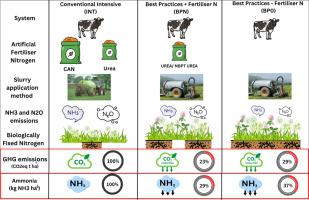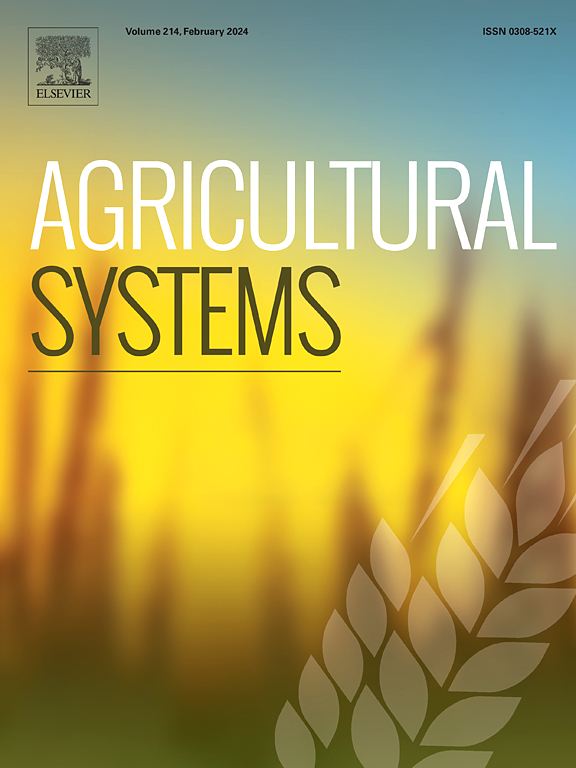Lowering the greenhouse gas and ammonia emissions from grassland-based dairy production
IF 6.1
1区 农林科学
Q1 AGRICULTURE, MULTIDISCIPLINARY
引用次数: 0
Abstract
CONTEXT
Lowering greenhouse gas (GHG) and ammonia emissions from ruminant production systems is critical to mitigating climate change and enrichment and acidification of vulnerable habitats. Quantifying emission reductions from the implementation of best practices (BP) on grassland-based dairy systems is essential to guide farmers and policy towards wider adoption of best practices.
OBJECTIVE
The aim was to evaluate the extent to which the adoption of BP lowered the GHG and ammonia emissions of grassland-based dairy systems per kg of fat protein corrected milk (FPCM) and per hectare (ha).
METHODS
Life cycle assessment was used to calculate emissions from systems of dairy production adopting BP. Data were collected from systems-scale experiments conducted at Solohead Research Farm, Co. Tipperary, Ireland (52°51′N, 08°21′W) between 2011 and 2022. There were three systems that had an average of 27 cows per system and an average annual stocking rate of 2.53 cows ha−1. INT was the control and included average annual fertiliser N input of 265 kg ha−1, applied as calcium ammonium nitrate (CAN 27.5% N) and urea (46 % N) and average annual clover content of grassland dry matter was 110 g kg−1, and slurry was applied by splash plate. BPN included average annual fertiliser N input of 99 kg ha−1 applied as urea or protected urea, clover content was 230 g kg−1 and slurry was applied by trailing shoe. BPO received minimal (<5 kg ha−1) inputs of fertiliser N, clover content was 280 g kg−1 and slurry was applied by trailing shoe. INT encompassed each of 7 experimental years, BPN 7 years and BPO 4 years. All relevant farm activity data was modelled on the basis of a 59 ha farm.
RESULTS AND CONCLUSIONS
GHG emissions averaged 1.05, 0.80 and 0.73 kg CO2e kg FPCM−1 (SEM = 0.035, P < 0.001) for INT, BPN and BPO respectively. GHG emissions per hectare were 15.0, 11.5 and 10.7 t CO2e (SEM = 0.485, P < 0.001). Ammonia emissions were lower from BPN and BPO compared with INT (P < 0.001). Replacing artificial fertiliser N with biologically fixed N (BFN) had the largest impact on GHG mitigation. Low emissions slurry spreading (LESS) in the form of the trailing shoe and replacing artificial fertiliser N with BFN had the greatest impact on ammonia emissions.
SIGNIFICANCE
Adopting BP lowered GHG emissions by up to 29 % and ammonia emissions by up to 37 % compared with a conventional intensive system of grassland-based milk production. These results can aid farmers to contribute to emissions reduction targets.

降低草地奶制品生产的温室气体和氨气排放
背景降低反刍动物生产系统的温室气体(GHG)和氨的排放对减缓气候变化、脆弱生境的富集和酸化至关重要。量化草地奶牛生产系统实施最佳实践(BP)所减少的排放量对于指导农民和政策更广泛地采用最佳实践至关重要。方法采用生命周期评估来计算采用最佳实践的奶牛生产系统的排放量。数据收集自在爱尔兰蒂珀雷里郡索洛黑德研究农场(Solohead Research Farm)进行的系统规模实验。爱尔兰蒂珀雷里郡索洛黑德研究农场(北纬 52°51′,西经 08°21′)在 2011 年至 2022 年期间进行的系统规模实验中收集的数据。共有三个系统,每个系统平均饲养 27 头奶牛,年平均放养率为 2.53 头/公顷。INT 是对照组,包括年均肥料氮输入量 265 kg ha-1,以硝酸铵钙(CAN 27.5% N)和尿素(46 % N)的形式施用,草地干物质中的年均苜蓿含量为 110 g kg-1,泥浆采用喷洒板施用。BPN 包括以尿素或保护尿素形式施用的年平均肥料氮输入量 99 千克/公顷,三叶草含量为 230 克/千克,泥浆以拖拉鞋施用。BPO 的氮肥投入量最小(5 千克/公顷),三叶草含量为 280 克/千克,泥浆采用拖曳式施肥。INT 包含 7 个实验年,BPN 包含 7 年,BPO 包含 4 年。结果和结论 INT、BPN 和 BPO 的温室气体平均排放量分别为 1.05、0.80 和 0.73 kg CO2e kg FPCM-1(SEM = 0.035,P < 0.001)。每公顷温室气体排放量分别为 15.0、11.5 和 10.7 吨 CO2e(SEM = 0.485,P < 0.001)。与 INT 相比,BPN 和 BPO 的氨排放量较低(P < 0.001)。用生物固定氮(BFN)替代人工化肥氮对温室气体减排的影响最大。与传统的集约化草地牛奶生产系统相比,采用 BP 可减少高达 29% 的温室气体排放和高达 37% 的氨气排放。这些结果有助于奶农实现减排目标。
本文章由计算机程序翻译,如有差异,请以英文原文为准。
求助全文
约1分钟内获得全文
求助全文
来源期刊

Agricultural Systems
农林科学-农业综合
CiteScore
13.30
自引率
7.60%
发文量
174
审稿时长
30 days
期刊介绍:
Agricultural Systems is an international journal that deals with interactions - among the components of agricultural systems, among hierarchical levels of agricultural systems, between agricultural and other land use systems, and between agricultural systems and their natural, social and economic environments.
The scope includes the development and application of systems analysis methodologies in the following areas:
Systems approaches in the sustainable intensification of agriculture; pathways for sustainable intensification; crop-livestock integration; farm-level resource allocation; quantification of benefits and trade-offs at farm to landscape levels; integrative, participatory and dynamic modelling approaches for qualitative and quantitative assessments of agricultural systems and decision making;
The interactions between agricultural and non-agricultural landscapes; the multiple services of agricultural systems; food security and the environment;
Global change and adaptation science; transformational adaptations as driven by changes in climate, policy, values and attitudes influencing the design of farming systems;
Development and application of farming systems design tools and methods for impact, scenario and case study analysis; managing the complexities of dynamic agricultural systems; innovation systems and multi stakeholder arrangements that support or promote change and (or) inform policy decisions.
 求助内容:
求助内容: 应助结果提醒方式:
应助结果提醒方式:


